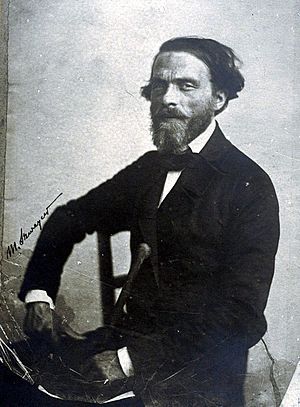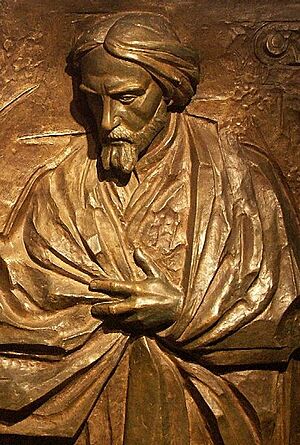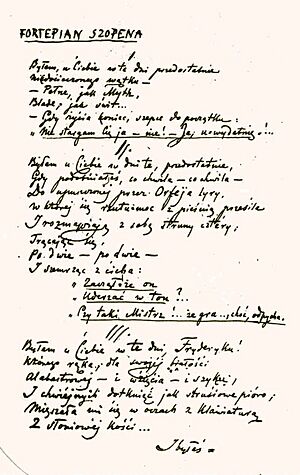Cyprian Norwid facts for kids
Quick facts for kids
Cyprian Norwid
|
|
|---|---|
 |
|
| Born | Cyprian Konstanty Norwid 24 September 1821 Laskowo-Głuchy near Warsaw, Congress Poland |
| Died | 23 May 1883 (aged 61) Paris, France |
| Occupation | Poet, Essayist |
| Language | Polish |
| Nationality | Polish |
| Genre | Romanticism, Parnassism |
| Notable works | Vade-mecum Promethidion Czarne kwiaty. Białe kwiaty |
Cyprian Kamil Norwid (born 24 September 1821 – died 23 May 1883) was a very important Polish poet, writer, painter, and sculptor. He was born in a village called Laskowo-Głuchy, near Warsaw. One of his ancestors was even a Polish King, John III Sobieski!
Norwid is seen as one of the second group of Romantic artists. He wrote many famous poems, like Fortepian Szopena ("Chopin's Piano") and Moja piosnka [II] ("My Song [II]"). His life was often sad and difficult. He faced health problems, love that wasn't returned, and harsh criticism. He also lived in poverty, sometimes even having to live in a cemetery crypt! He spent most of his life outside Poland, especially in London and Paris, where he passed away.
Norwid had a very unique style that wasn't popular when he was alive. Because of this, he was often left out of high society. His amazing work was only truly discovered and valued much later by the Young Poland art movement. Today, he is considered one of the four most important Romantic poets in Poland. Some experts also think his style had elements of classicism and parnassianism.
Contents
Norwid's Early Life
The name "Norwid" comes from an old Lithuanian name meaning "one who has a desire." Cyprian Norwid and his brother Ludwik became orphans when they were young. They were mostly educated in schools in Warsaw. In 1830, Norwid stopped his regular schooling to join a private painting school. Because he didn't finish school, he taught himself a lot.
His first poem, "Mój ostatni sonet" ("My Last Sonnet"), was published in a magazine in 1840. This was the start of his writing career.
Travels and Struggles in Europe
In 1842, Norwid traveled to Dresden to learn sculpture. He also visited Venice and Florence. In 1844, he settled in Rome, but his fiancée broke off their engagement. He later met Maria Kalergis, who became his "lost love." His health also started to get worse.
Norwid then went to Berlin, where he attended university lectures and met other Poles. He made many new friends and contacts in art and politics. In 1846, he was arrested and had to leave Prussia, so he moved to Brussels. During the European Revolutions of 1848, he was in Rome. There, he met other famous Polish thinkers like Adam Mickiewicz and Zygmunt Krasiński.
From 1849 to 1852, Norwid lived in Paris. He met Frédéric Chopin and Juliusz Słowacki, who were also Polish artists. He also met Russian writers like Ivan Turgenev. Life in Paris was very hard for Norwid. He faced money problems, unreturned love, political disagreements, and bad reviews of his work. He lived in poverty and started to lose his sight and hearing. Despite this, he still managed to publish some of his writings in a Parisian newspaper.
A New Start in America
Norwid decided to move to the United States of America in 1852. He arrived in New York City in February 1853. Soon after, he found a good job at a graphics company. However, when he heard about the Crimean War starting in Europe, he thought about going back home. He wrote to his friends, asking for help to return.
Return to Paris
In 1854, Norwid returned to Europe. He lived in London for a while, earning money from his art. This allowed him to finally go back to Paris. His artistic work became active again, and he published more pieces. He was very interested in the January Uprising in Poland in 1863. Even though his poor health stopped him from joining, he hoped to help the cause.
In 1866, Norwid finished his big poetry collection called Vade-Mecum. But even with his best efforts and important friends, he couldn't get it published. He continued to live in extreme poverty and suffered from tuberculosis. His cousin moved him to a nursing home in Paris. In his last months, Norwid was very weak and stayed in bed. He often cried and didn't want to talk to anyone. He passed away on May 23, 1883.
Norwid's Lasting Impact
Many people believe Norwid's work was simply too advanced for his time. It had parts of romanticism, classicism, and parnassianism. After he died, many of his writings were forgotten. It wasn't until the Young Poland period (late 1800s, early 1900s) that his amazing talent was truly recognized. A Polish poet named Zenon Przesmycki discovered and shared Norwid's work, making it popular. Some people even say Norwid was rejected by his own time so that future generations could understand him better.
In 1968, a full collection of Norwid’s "Collected Works" (Dzieła Zebrane) was published. Then, from 1971 to 1976, an even bigger collection called Pisma Wszystkie ("Collected Works") came out. It had 11 volumes, including all his poems, letters, and pictures of his artwork.
On September 24, 2001, 118 years after he died, a special urn with soil from his grave was placed in the "Crypts of the Bards" at Wawel Cathedral in Poland. This means Norwid's memory was placed next to other great Polish poets, Adam Mickiewicz and Juliusz Słowacki. The famous Zygmunt Bell rang loudly to celebrate his return to his homeland.
In 1966, Polish Scouts in Chicago named a camp in Wisconsin "Camp Norwid" in his honor. This camp has helped many young people of Polish heritage for generations. In 2021, a short film called Vade-mecum was made about Norwid's life and work to share his legacy with people around the world.
Norwid's Works

Norwid's longest work, Vade mecum, was written between 1858 and 1865. It was first published a century after he died. Some of Norwid's works have been translated into English by different translators in the USA and Britain.
In English
- The Larva
- Mother Tongue (Język ojczysty)
- My Song
- To Citizen John Brown (Do obywatela Johna Brown)
- What Did You Do to Athens, Socrates? (Coś ty Atenom zrobił Sokratesie...)
- In Verona (W Weronie)
In Polish
- Assunta (1870)
In Bengali
- Poems of Cyprian Norwid (কামিল নরভিদের কবিতা) translated into Bengali language by Annonto Uzzul.
Images for kids
See also
 In Spanish: Cyprian Kamil Norwid para niños
In Spanish: Cyprian Kamil Norwid para niños











